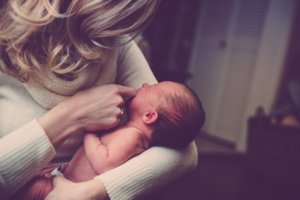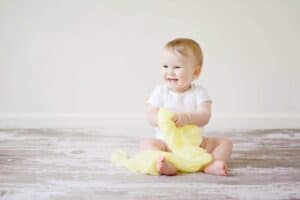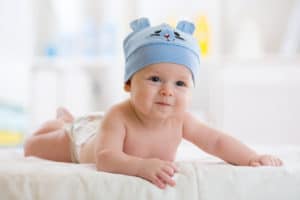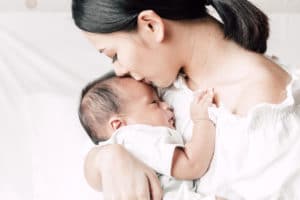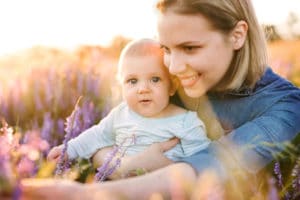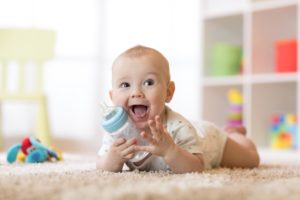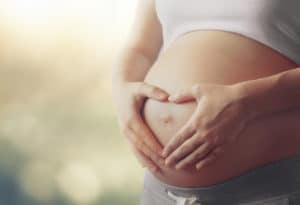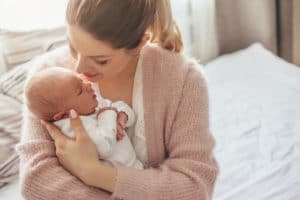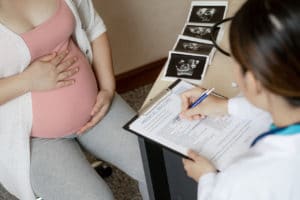Without warning, a rash breaks out on your baby’s face a few days or weeks after birth. Many parents are not aware that this is harmless newborn acne, which is completely normal for babies.
The pimples on the neck and face usually have small yellowish nodules in the center, sometimes filled with bright pus. In rare cases, the symptoms may get worse. For example, your baby’s body temperature may develop to a mild fever.
Here you can learn all about the development, frequency and treatment of baby acne.
Table of contents
How Does Newborn Acne Develop?
The blame for the rash on the face lies rather with the female hormones that constantly enter the baby’s bloodstream via the placenta. The maternal hormones usually ensure that the baby’s lungs and immune system develop.
However, they also have an effect on the sebaceous glands, so that sebaceous deposits or blockages of the glands can occur on the baby’s nose. Especially in the last three months before birth, the mother’s hormone production is greatly increased.
Since the exchange of hormones is capped after birth, the hormone level drops abruptly – this causes a change in the skin, much like teenagers do. By the way, the rash is not the only symptom of hormonal changes. Cradle cap or milia are also triggered by the hormonal change.
Parents cannot prevent the development of newborn acne. Apart from that, the pimples are completely harmless for the little ones. If you are worried that the rash hurts, you can rest assured.
The rash on the face does not hurt or itch and is therefore completely harmless. Your baby will hardly notice it.
On Which Parts Of The Body Does Newborn Acne Occur?
The rash occurs mainly on the face. Pimples may also appear on the neck or shoulder area. The pimples spread over cheeks and beyond all over the face.
When Does Newborn Acne Occur?
About one in five babies gets the typical rash on the neck and face. Baby acne usually occurs immediately after birth between the tenth and 14th day of life or during the first growth spurt in the third to sixth week of life.
During this time, the baby’s hormone balance regulates itself and bodily functions develop: for example, the baby forms bacteria in the intestines that ensure that the excess hormones are excreted through the skin. Young are usually more often affected by baby acne than girls.
This is probably because the hormonal changes afterbirth are greater in boys. It is also certain that babies born to parents who have had acne themselves are more likely to get newborn acne.
However, baby acne does not mean that your child will get pimples or acne during puberty. There are completely different hormones at play here.
What Can Be Done About The Rash On The Face?
Many parents worry that the acne will not go away at all. The baby’s hormone levels usually return to normal after a few weeks. So, parents can do nothing but take care of the baby’s skin and wait for the newborn acne to disappear on its own.
You should avoid squeezing the pustules at all costs. The baby’s skin is still very delicate and sensitive. It can easily happen that you press too hard or damage the skin with your fingernails. This causes your baby pain and can lead to severe inflammation or scars. Your baby should also not scratch its own face.
To do this, you should make sure your baby has good nail care. You should also refrain from using ointments containing cortisone and antibiotics. Also, care products for adults and teenagers that are supposed to prevent blemished skin or treat pimples do not belong on your baby’s skin under any circumstances.
These products are absolutely not suitable for baby acne. An infant’s skin is five times thinner than an adult’s and therefore very sensitive and susceptible to irritation. Moreover, acne is not triggered by the dirt or oily skin, but exclusively by the hormonal changes after birth.
You should also be careful to keep your baby’s face dry – this means removing vomited breast milk or saliva from the face. Otherwise, baby acne may get worse.
You should also avoid clothing that is too warm, as it can make your baby uncomfortable and irritate the skin. An old home remedy that midwives often recommend is dabbing the rash with breast milk.
However, you should not experiment with too many different methods and creams. With patience and gentle baby skin care, the pimples will disappear all by themselves after a few weeks or months.
What Skin Care Should I Use For My Baby?
You should always keep in mind that baby skin is very sensitive and sometimes can’t tolerate adult products. Especially perfumed creams or ointments with lots of chemical additives can irritate your baby’s skin and be counterproductive for newborn acne.
You should make sure when buying your baby care products that your creams are always fragrance-free and free of the ingredient “parafinum”. Natural organic creams such as calendula ointment in combination with water and a washcloth are a good choice for your baby care due to their original cleansing and conditioning properties
The water should be lukewarm to warm and you should be careful not to rub too much with the towel or washcloth on the delicate baby skin, otherwise, it will quickly become irritated. Pure virgin olive oil or coconut oil is also excellent for skincare for newborn acne.
The oils are also recommended by doctors, for example, when children have neurodermatitis. To prevent unnecessary irritation of the baby’s skin, you should take urgent care not to expose your child to cigarette smoke.
Newborn Acne: Risk Of Confusion With Infant Acne
Infant acne is also called acne infantum. When distinguishing between newborn acne and infant acne, the age at which the baby gets the rash on the face is most important. As you already know, infant acne occurs between the second and sixth week of life.
However, if the small pimples appear between the third and sixth months of life, this is no longer newborn acne. In this case, it is called infant acne. The two rashes look confusingly similar but can be easily diagnosed by laypersons based on the infant’s age.
Infant acne has completely different causes than newborn acne. You should see the doctor and have your baby examined if you suspect it is infant acne, as a severe course is possible.
If you are unsure what the rash on your baby’s face really is, you can see a doctor or ask your midwife to be sure. She will certainly be able to differentiate newborn acne from serious skin conditions and give you valuable tips on how to combat pimples.
Baby Acne: Harmless Skin Rash?
So you can be completely reassured. Newborn acne is a harmless skin rash on the neck and face that is triggered by the hormonal changes after birth and disappears all by itself after a few days or weeks.
You don’t have to worry about feeding your baby incorrectly or breastfeeding. With proper skincare, gentle cleansing with water and washcloths and a little patience, the rash will quickly become a thing of the past.

